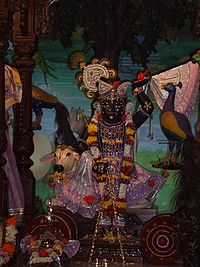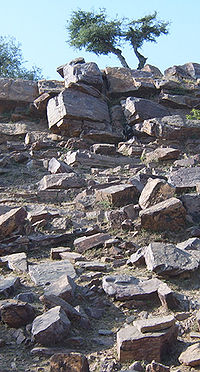
Madhavendra Puri
Encyclopedia

Biography
Very little is known about early years of Madhavendra Puri, as in majority of sources he is figuring already a mendicant, sannyasi. After making an extensive pilgrimage of India as a sannyasi he passed his life in Vrndavana and Orissa. The main source of knowledge about this personality is Caitanya Caritamrita. What is known that he was a sannyasi of the Sankara sampradaya order, however he also belongs to Madhva line being a disciple of Lakshmipati TirthaLakshmipati Tirtha
Lakshmipati Tirtha was a Vaishnava saint. He was a disciple of Vyasatirtha who gave him the name 'Lakshmipati Tirtha' upon initiation...
and it appears that Madhavendra was the founder of the Vaishnava centre at Mathura, Vrindavana. He is considered a fountainhead of devotional worship of Krishna and he has started the worship of the Gopala deity, better known as Shrinathji
Shrinathji
Shrinathji is an anthropomorphic form of Hindu god Krishna, manifest as a seven year old child . The principal shrine of Shrinathji is situated at the temple town of Nathdwara, located 48 Kilometers North-east of Udaipur city in Rajasthan...
. He is attributed to mysterious discovery of the famous deity of Gopala near Govardhana that was later worshiped by Vallabhacharya, follower of Vishnuswami in Rudra sampradaya, who in turn was influenced by devotional mood of Vrindavana.

Krishna
Krishna is a central figure of Hinduism and is traditionally attributed the authorship of the Bhagavad Gita. He is the supreme Being and considered in some monotheistic traditions as an Avatar of Vishnu...
, who commanded him to travel for the supply of scarce sandal wood paste from the Orissa to Malaya Mountains.
Initiating sankirtana movement
Madhavendra Puri is often accepted as initial inspiration or initiator of the movement of Chaitanya MahaprabhuChaitanya Mahaprabhu
Chaitanya Mahaprabhu was a Vaishnava saint and social reformer in eastern India in the 16th century, believed by followers of Gaudiya Vaishnavism to be the full incarnation of Lord Krishna...
, who accepted Madhavendras intimate disciple, Isvara Puri
Isvara Puri
Isvara Puri was a monk of the renunciate order in the Sankarite from Srigeri Saradha Pithan Isvara Puri was a monk of the renunciate order in the Sankarite from Srigeri Saradha Pithan Isvara Puri was a monk of the renunciate order in the Sankarite from Srigeri Saradha Pithan (follow the "puri" name...
as his diksa guru
Guru
A guru is one who is regarded as having great knowledge, wisdom, and authority in a certain area, and who uses it to guide others . Other forms of manifestation of this principle can include parents, school teachers, non-human objects and even one's own intellectual discipline, if the...
. He is believed to be preaching the principles of Gaudiya Vaishnavism
Gaudiya Vaishnavism
Gaudiya Vaishnavism is a Vaishnava religious movement founded by Chaitanya Mahaprabhu in India in the 16th century. "Gaudiya" refers to the Gauḍa region with Vaishnavism meaning "the worship of Vishnu"...
prior to Caitanya.
Service in separation
It is believed that Caitanya Mahaprabhu’s service in feelings of separation viraha begins with a single verse spoken by Madhavendra Puri, (his grand preceptor):"O, my beloved Lord, the friend of the afflicted! He Mathura-natha, when, when shall I see you? Without seeing you, my heart is perplexed, my beloved, and I am very restless! What am I to do?"
Lineage
In accordance with Gaudiya Vaishnava sources he is believed to belong to MadhvacharyaMadhvacharya
Madhvācārya was the chief proponent of Tattvavāda "Philosophy of Reality", popularly known as the Dvaita school of Hindu philosophy. It is one of the three most influential Vedānta philosophies. Madhvācārya was one of the important philosophers during the Bhakti movement. He was a pioneer in...
lineage
Parampara
Parampara denotes a succession of teachers and disciples in traditional Indian culture and Indian religions such as Hinduism, Sikhism, Jainism and Buddhism...
that has been transcribed in the books like Gaura-ganoddesa-dipika, Prameya-ratnavali and the writings of Gopala Guru Goswami. There is a version of this line of gurus recorded as a version found in the Gaura-ganoddesa-dipika which matches other historical records. He had many disciples but Advaita Acarya
Advaita Acharya
Advaita Acharya , born Kamalaksha Bhattacharya, was a notable disciple and companion of the founder of the Gaudiya Vaishnava sect, Chaitanya Mahaprabhu, and guru of Haridasa Thakur...
and Isvara Puri
Isvara Puri
Isvara Puri was a monk of the renunciate order in the Sankarite from Srigeri Saradha Pithan Isvara Puri was a monk of the renunciate order in the Sankarite from Srigeri Saradha Pithan Isvara Puri was a monk of the renunciate order in the Sankarite from Srigeri Saradha Pithan (follow the "puri" name...
are believed to be the chief disciples
Guru-shishya tradition
The guru-shishya tradition, lineage, or parampara, denotes a succession of teachers and disciples in traditional Indian culture and religions such as Hinduism, Sikhism, Jainism and Buddhism. It is the tradition of spiritual relationship and mentoring where teachings are transmitted from a guru...
of Madhavendra Puri.
Early History of the famous deity of Gopinatha (Ksirachora) is not given in Gaudiya texts – it is given by Vinod Bijaya Babaji in Gopinatha Caritamrta. However there is large account of his interactions with this Deity in Caitanya caritamrita, the foundational book for the Gaudiya Vaishnavas.
Memorial
Madhavendra Puri died in RemunaRemuna
Remuna is a town and a notified area committee in Baleswar district in the Indian state of Orissa.-Geography:Remuna is located at . It has an average elevation of 20 metres .-Demographics:...
, his memorial Samādhi
Samadhi
Samadhi in Hinduism, Buddhism,Jainism, Sikhism and yogic schools is a higher level of concentrated meditation, or dhyāna. In the yoga tradition, it is the eighth and final limb identified in the Yoga Sūtras of Patañjali....
and sandals are still worshiped there. It is a place of pilgrimage for many Vaishnava groups.

